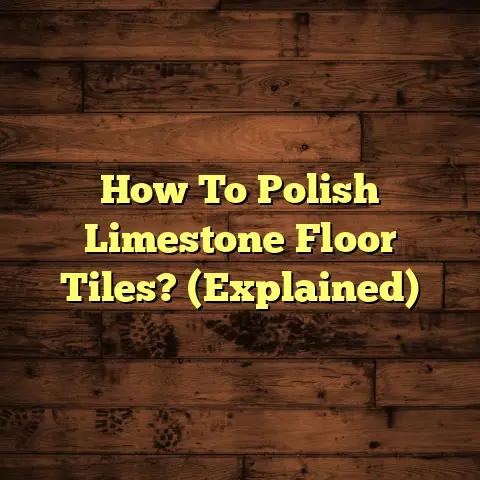Vinyl Over Hardwood? (1 BIG Flooring No-No!)
Have you ever paused to think about what happens when you cover up your beautiful hardwood floors with vinyl?
It’s a question I often get asked as a flooring contractor, and it’s a crucial one. Let’s dive deep into why putting vinyl over hardwood might not be the best idea, exploring the risks, alternatives, and what to consider for your home.
1. Understanding the Basics of Flooring
Let’s start with the fundamentals. What exactly are we talking about when we say “vinyl” and “hardwood” flooring?
Vinyl flooring is a synthetic material made from PVC (polyvinyl chloride) and other compounds. It comes in various forms, like sheets, tiles, and planks, mimicking the look of wood, stone, or other materials. It’s known for being water-resistant, durable, and relatively inexpensive.
Hardwood flooring, on the other hand, is made from solid wood, such as oak, maple, or cherry. It’s prized for its natural beauty, durability (when properly maintained), and the warmth it brings to a space.
Both materials are incredibly popular, but for different reasons. Vinyl appeals to those seeking a budget-friendly, low-maintenance option, while hardwood attracts those who value timeless elegance and a natural feel.
Now, the idea of layering flooring materials isn’t new. Homeowners often explore it to save on removal costs or to quickly update a room’s appearance. But is it always the right move?
2. The Appeal of Vinyl Over Hardwood
Why would someone even think about covering up hardwood with vinyl? Well, there are a few compelling reasons.
-
Cost: Vinyl is significantly cheaper than hardwood. If you’re on a tight budget, installing vinyl over existing hardwood might seem like a quick and affordable way to refresh a room.
-
Ease of Installation: Vinyl flooring, especially the click-lock plank variety, is relatively easy to install. Many DIYers feel confident tackling this project themselves, saving on labor costs.
-
Aesthetics: Perhaps you simply don’t like the look of your current hardwood. Maybe it’s outdated, damaged, or just not your style. Vinyl offers a wide range of styles and patterns that can instantly transform a space.
-
Trends: Home renovation trends often play a role. For example, the rise of waterproof flooring has led many to consider vinyl as a practical solution, even if they already have hardwood.
I’ve seen homeowners drawn to the promise of a fast and inexpensive makeover. But, as with many things in life, there’s more to the story than meets the eye.
3. The Structure and Composition of Hardwood Flooring
To understand the risks, we need to appreciate the nature of hardwood flooring. It’s not just a pretty surface; it’s a living, breathing material.
Hardwood floors are typically constructed from planks of solid wood or engineered wood. Solid hardwood is a single piece of wood, while engineered hardwood consists of a thin layer of hardwood veneer bonded to a core of plywood or other composite material.
The type of wood and the finish applied play a crucial role in the floor’s durability and appearance. Oak, maple, and hickory are popular choices for their hardness and grain patterns. Finishes can range from traditional polyurethane to more modern oil-based or water-based options.
Maintaining the integrity of hardwood is vital for several reasons:
-
Home Value: Hardwood floors are a desirable feature that can significantly increase a home’s resale value. Covering them up can be seen as a downgrade.
-
Aesthetics: The natural beauty of hardwood is unmatched. It adds warmth, character, and a sense of luxury to any space.
-
Longevity: With proper care, hardwood floors can last for decades, even centuries. Covering them up can shorten their lifespan.
Think of your hardwood floors as an investment. You want to protect that investment, not bury it under a layer of vinyl!
4. The Composition of Vinyl Flooring
Now, let’s switch gears and look at vinyl flooring in more detail. As I mentioned earlier, vinyl is a synthetic material, but there’s more to it than just PVC.
Vinyl flooring comes in several forms:
-
Sheet Vinyl: This comes in large rolls and is typically used in areas where water resistance is paramount, such as bathrooms and kitchens.
-
Vinyl Tile: Individual tiles that can be arranged in various patterns.
-
Vinyl Plank: Designed to mimic the look of hardwood, vinyl planks are often click-lock, making them easy to install.
Regardless of the form, vinyl flooring typically consists of several layers:
-
Wear Layer: The top layer that protects the floor from scratches, stains, and wear.
-
Print Layer: This layer contains the design or pattern that gives the vinyl its appearance.
-
Core Layer: Provides stability and cushioning.
-
Backing Layer: The bottom layer that adheres to the subfloor.
Vinyl’s benefits are undeniable:
-
Water Resistance: Vinyl is highly water-resistant, making it suitable for bathrooms, kitchens, and basements.
-
Durability: Vinyl is tough and can withstand heavy foot traffic.
-
Low Maintenance: Vinyl is easy to clean and requires minimal upkeep.
-
Affordability: As we’ve already discussed, vinyl is a budget-friendly flooring option.
But these benefits don’t automatically make it a good choice for covering hardwood. There are potential downsides to consider.
5. The Potential Risks of Installing Vinyl Over Hardwood
This is where things get interesting. While the idea of vinyl over hardwood might seem appealing on the surface, there are several risks involved.
-
Moisture Trapping: Hardwood needs to breathe. When you cover it with vinyl, you restrict airflow and trap moisture. This can lead to cupping, warping, and even rot in the hardwood beneath.
I’ve seen firsthand the damage that trapped moisture can cause. It’s not pretty, and it can be expensive to repair.
-
Weight and Rigidity: Vinyl flooring, especially thicker planks, can put stress on the hardwood underneath. This can cause the hardwood to flex or crack, especially if it’s already old or weak.
-
Flooring Height and Transitions: Adding a layer of vinyl over hardwood will raise the floor height. This can create awkward transitions between rooms and potentially interfere with doors and cabinets.
I had a client who installed vinyl over their hardwood in the kitchen. They ended up having to trim all their baseboards and adjust the height of their dishwasher to make it fit!
-
Resale Value: As I mentioned earlier, hardwood floors are a selling point. Covering them with vinyl can detract from the home’s value and make it harder to sell.
Potential buyers might see it as a sign that the hardwood is in poor condition, even if it’s not.
-
Adhesive Issues: Depending on the type of vinyl and adhesive used, removing the vinyl later can damage the hardwood. The adhesive can pull up the finish or even damage the wood itself.
I strongly advise against using any adhesive directly on the hardwood. If you must install vinyl over hardwood, opt for a floating installation method.
These risks are not just theoretical. They are based on real-world experiences and expert opinions. Let’s take a look at some case studies.
6. Case Studies and Real-World Examples
I’ve seen a lot of flooring projects in my career, and I can tell you that vinyl over hardwood often leads to trouble.
-
The Case of the Cupping Hardwood: A homeowner decided to install vinyl sheet flooring over their existing hardwood in the bathroom. Within a year, they noticed the hardwood starting to cup and warp. The moisture from the bathroom was trapped under the vinyl, causing the hardwood to deteriorate.
-
The Story of the Cracked Planks: Another homeowner installed thick vinyl planks over their hardwood in the living room. Over time, they noticed cracks appearing in the hardwood, especially in high-traffic areas. The weight and rigidity of the vinyl were too much for the aging hardwood to handle.
These are just two examples, but I’ve seen similar scenarios play out time and time again.
I spoke with Sarah Miller, a certified home inspector with 15 years of experience. She says, “I often see issues with hardwood floors that have been covered with vinyl. Moisture damage is the most common problem, but I also see issues with unevenness and damage from adhesive.”
John Davis, a flooring specialist at a local retailer, adds, “While vinyl is a great product in the right situation, covering hardwood is rarely the right choice. It’s usually better to refinish or restore the hardwood instead.”
The consensus among flooring professionals is clear: vinyl over hardwood is a risky proposition.
7. Long-Term Effects on Hardwood Flooring
Let’s zoom out and consider the long-term consequences of covering your hardwood with vinyl.
-
Preventing Proper Maintenance: Hardwood floors require regular maintenance, such as cleaning, polishing, and occasional refinishing. Covering them with vinyl prevents you from properly caring for them.
-
Mold and Mildew Growth: Trapped moisture can create a breeding ground for mold and mildew. This can not only damage the hardwood but also pose a health risk to your family.
I’ve seen homes where the mold growth was so severe that the hardwood had to be completely replaced.
-
Reduced Lifespan: By preventing proper maintenance and trapping moisture, vinyl can significantly shorten the lifespan of your hardwood floors.
-
Hidden Damage: The worst part is that you might not even realize the damage is occurring until it’s too late. The vinyl hides the problem, allowing it to worsen over time.
Think of it like this: you’re putting a band-aid on a wound without cleaning it first. The wound will fester and get worse under the band-aid.
8. Alternatives to Vinyl Over Hardwood
Okay, so vinyl over hardwood is generally a bad idea. What are the alternatives?
-
Refinishing or Restoring Hardwood: If your hardwood is simply outdated or damaged, consider refinishing or restoring it. This can bring your floors back to their former glory without compromising their integrity.
I’ve seen some incredible transformations through refinishing. It’s amazing what a little sanding and a fresh coat of finish can do.
-
Area Rugs: If you want to add warmth or style to a room without covering the entire floor, consider using area rugs. They can define spaces and add visual interest without trapping moisture.
-
Other Flooring Options: If you’re set on replacing your hardwood, explore other flooring options that are compatible with your subfloor and your lifestyle. Laminate, tile, and engineered wood are all viable alternatives.
-
Professional Assessment: Before making any decisions, consult with a flooring professional. They can assess the condition of your hardwood and recommend the best course of action.
I always tell my clients, “It’s better to spend a little money on a professional assessment upfront than to make a costly mistake down the road.”
9. Conclusion
So, let’s recap. Installing vinyl over hardwood is generally a bad idea due to the risks of moisture trapping, damage to the hardwood, reduced resale value, and potential health hazards.
While the idea of a quick and inexpensive makeover might be tempting, the long-term consequences can be significant.
I urge you to consider the long-term value of your flooring choices. Your floors are an investment, and they deserve to be treated with care.
Before you cover up your beautiful hardwood floors, ask yourself: is it really worth the risk?





